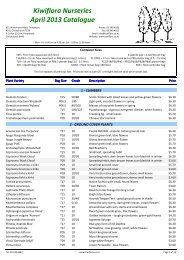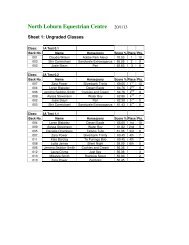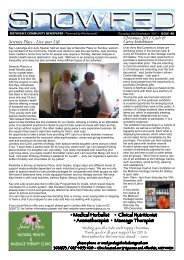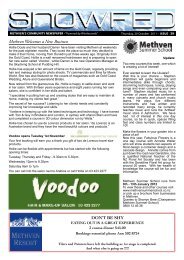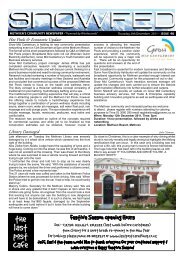You also want an ePaper? Increase the reach of your titles
YUMPU automatically turns print PDFs into web optimized ePapers that Google loves.
OPERATING INSTRUCTIONS & SCOOTER HANDBOOK<br />
JM JM STAR STAR SUNNY SUNNY 50 SCOOTER SCOOTER<br />
WWW.SUNNYSCOOTER.CO.NZ
PREFACE<br />
Thank you for choosing to buy a <strong>Sunny</strong> 50 s<strong>co</strong>oter from AVF Imports.<br />
Your JM Star <strong>Sunny</strong> 50 s<strong>co</strong>oter is EEC (European E<strong>co</strong>nomic Community) Certified, thorough<br />
checks have been carried out along the assembly line to ensure it has been built to the<br />
best possible standard.<br />
We are sure you will enjoy owning your s<strong>co</strong>oter. Please take a few minutes to read through<br />
this handbook and familiarize yourself with the features your s<strong>co</strong>oter has as well as some<br />
safety and riding tips.<br />
WWW.SUNNYSCOOTER.CO.NZ
1) Basic information about your s<strong>co</strong>oter<br />
2) Know your s<strong>co</strong>oter – Left hand side<br />
3) Know your s<strong>co</strong>oter – Right hand side<br />
4) Storage on your s<strong>co</strong>oter<br />
5) Loading restrictions<br />
6) Steering Lock, Seat Lock & Fuel cap<br />
7) Electric starting your s<strong>co</strong>oter<br />
8) Kick Starting your s<strong>co</strong>oter<br />
9) Headlight and indicator <strong>co</strong>ntrols<br />
10) Operating your s<strong>co</strong>oter<br />
11) Braking<br />
CONTENTS<br />
12) Parking your s<strong>co</strong>oter<br />
13) Tips for safe riding<br />
14) Be aware of road <strong>co</strong>nditions<br />
15) Be aware of your surroundings<br />
16) <strong>S<strong>co</strong>oter</strong>s on hills<br />
17) Fuel and Oil<br />
18) Running in & caring for your s<strong>co</strong>oter<br />
19) Can I ungovern my s<strong>co</strong>oter?<br />
20) Battery and fuse<br />
21) Electrical Diagram<br />
22) Contact Information
1) Basic information about your s<strong>co</strong>oter<br />
The JM Star <strong>Sunny</strong> 50 s<strong>co</strong>oter has a 50cc 4 Stroke<br />
engine. To ensure a long engine life it is<br />
important to take good care of your s<strong>co</strong>oter and<br />
have it serviced at regular intervals as outlined in<br />
this manual and on your warranty card.<br />
The s<strong>co</strong>oters do not need a warrant of Fitness as<br />
they are classed as a moped.<br />
The LTSA classes the JM Star <strong>Sunny</strong> 50 s<strong>co</strong>oter as:<br />
“LA – Moped with 2 wheels”<br />
The maximum power output of your s<strong>co</strong>oter is<br />
2.0KW (This is governed – see page 19 for more)<br />
<strong>S<strong>co</strong>oter</strong> Dimensions:<br />
200cm long x 85cm wide x 130cm high.<br />
Seat height is 70cm.<br />
Fuel type = 91 unleaded<br />
Engine Oil = 10W40 4-Stroke<br />
Transmission Oil = 80W90<br />
Sparkplug = NGK-C7HSA<br />
Tire pressure = 35psi<br />
Battery = 12V 4Ah<br />
Fuse = 12V 10A<br />
You can ride your s<strong>co</strong>oter on a car<br />
license, even a learner’s license
2) Know your s<strong>co</strong>oter – Left hand side
3) Know your s<strong>co</strong>oter - Right hand side
4) Storage on your s<strong>co</strong>oter<br />
There are three main storage areas on your<br />
s<strong>co</strong>oter. There is a glove box in front under the<br />
handlebars, a storage box on the back of the<br />
s<strong>co</strong>oter and the under-seat storage.<br />
Refer to the next page for the loading restrictions<br />
for each of these storage options.<br />
Both the rear storage box and the under-seat<br />
storage are secure and lockable. The rear storage<br />
box can be detached <strong>co</strong>mpletely from the<br />
s<strong>co</strong>oter but only once it has been unlocked. The<br />
rear storage box is fitted with a reflector.<br />
You should have received 2 small keys for the<br />
rear storage box as well as the two main keys.<br />
There are several ways to store your helmet on<br />
the s<strong>co</strong>oter. Some helmets will fit inside the rear<br />
storage box or in the under seat storage space.<br />
Alternatively you can clip your helmet onto the<br />
helmet lock under the front of the seat as shown<br />
below. Once the seat is locked down the helmet<br />
cannot easily be removed from this position.<br />
The main ignition key will turn the s<strong>co</strong>oter on and<br />
off, lock the steering on the s<strong>co</strong>oter, open the<br />
under seat storage area and also unlock the fuel<br />
cap. The small key is for the rear storage box.
5) Loading restrictions<br />
The maximum rated load on the s<strong>co</strong>oter is 150KG,<br />
this can be made up of a single rider or a rider<br />
with passenger. For example the rider might<br />
weigh 90KG and the passenger 60KG, to give a<br />
total weight of 150KG. This s<strong>co</strong>oter is not<br />
re<strong>co</strong>mmended for people who weigh over 150KG<br />
by themselves. The s<strong>co</strong>oter itself weighs 86KG.<br />
The maximum weight limit for the under seat<br />
storage is 10KG, the maximum weight limit for<br />
the rear storage box is 5KG.<br />
NEVER let a passenger sit on the rear rack. The<br />
weight limit on the rack is just 5KG and damage<br />
will occur to your s<strong>co</strong>oter is a passenger puts<br />
their full weight on the rack.<br />
Never carry a load on your s<strong>co</strong>oter which<br />
protrudes sideways beyond the line of your<br />
mirrors or further forward or back of the<br />
extremities of your s<strong>co</strong>oter. Loads outside of<br />
these areas can upset the balance of your<br />
s<strong>co</strong>oter and also can be dangerous to other road<br />
users and or pedestrians.
6) Steering Lock, Seat Lock & Fuel cap<br />
To lock the steering<br />
turn the handlebars<br />
<strong>co</strong>mpletely to the left.<br />
Turn the key<br />
anticlockwise to the<br />
‘LOCK’ position and<br />
remove the key.<br />
It is a good habit to lock<br />
the steering whenever<br />
you park your s<strong>co</strong>oter<br />
in a public place. It is a<br />
good theft deterrent.<br />
The main s<strong>co</strong>oter key will unlock the seat, the<br />
seat is locked again by pressing down firmly on<br />
the back of the seat over the latch.<br />
The fuel cap is also unlocked using the main<br />
s<strong>co</strong>oter key. As an additional feature the key<br />
cannot be removed from the fuel cap until it is<br />
put back into place and relocked. This helps<br />
avoid losing the fuel cap.<br />
You should have received 2 main keys and 2 small<br />
keys (for the rear lock box) with your s<strong>co</strong>oter. It is<br />
a good idea to separate these as soon as possible<br />
to avoid losing all the keys together.
7) Electric starting your s<strong>co</strong>oter<br />
Turn the ignition key to the ON<br />
position. The Horn and<br />
indicators should now operate.<br />
The headlights won’t operate<br />
until the engine is running.<br />
Check that the s<strong>co</strong>oter has enough fuel to start.<br />
Press the starter button in.<br />
Hold for a se<strong>co</strong>nd or two till<br />
you hear the engine fire.<br />
Hold either one of<br />
the brake levers in<br />
Your s<strong>co</strong>oter is fitted with an automatic choke;<br />
you may hear the engine speed increase for<br />
approximately 3 minutes until the engine<br />
reaches its optimal operating temperature.<br />
There are two important things to note when it<br />
<strong>co</strong>mes to starting your s<strong>co</strong>oter:<br />
1) One of the brake levers must be held in<br />
for the starting button to operate.<br />
2) The side stand MUST be up.<br />
There is a safety cut out switch on the<br />
side stand. Your s<strong>co</strong>oter WILL NOT<br />
start with the side stand down
8) Kick starting your s<strong>co</strong>oter<br />
As a general rule you should use the electric<br />
starter to start your s<strong>co</strong>oter. You would usually<br />
only use the kick starter as an emergency start; ie:<br />
in the event of a flat battery.<br />
Ensure the s<strong>co</strong>oter is on its centre stand (If the<br />
centre stand is in its folded up position it will<br />
interfere with the path of the kick start lever)<br />
Turn the ignition key to the<br />
ON position.<br />
Hold either one of the<br />
brake levers in<br />
While holding the left<br />
handlebar with your<br />
left hand and<br />
supporting the s<strong>co</strong>oter<br />
with your right hand<br />
on the rear rack give a<br />
firm kick on the<br />
kickstart bar.<br />
CAUTION: If you start your s<strong>co</strong>oter while it is<br />
on its centre stand the auto choke may cause the<br />
clutch to engage and the rear wheel will start to<br />
spin. Take care to use the rear brake to stop the<br />
wheel spinning before taking it off its centre<br />
stand. Otherwise the s<strong>co</strong>oter may lurch forward<br />
when the rear wheel suddenly <strong>co</strong>mes in <strong>co</strong>ntact<br />
with the ground.
9) Headlight and indicator <strong>co</strong>ntrols<br />
The headlight switch has<br />
three positions.<br />
1) OFF<br />
2) Park lights ON<br />
(Includes Dashboard)<br />
3) Headlight ON<br />
The high/low selector<br />
switch is on the left<br />
handlebar. Only use high<br />
beam when no other<br />
traffic is around.<br />
NOTE: The Headlights will only work<br />
when the engine is running<br />
The indicator can be<br />
turned on by pushing<br />
the switch sideways in<br />
either direction. To stop<br />
the indicators push the<br />
switch in.<br />
ALWAYS indicate at least 3 se<strong>co</strong>nds<br />
before turning or changing lanes.
10) Operating your s<strong>co</strong>oter<br />
Ensure the side stand<br />
is up and start your<br />
s<strong>co</strong>oter. Support the<br />
balance of the s<strong>co</strong>oter<br />
with one foot on the<br />
ground.<br />
The s<strong>co</strong>oters are fitted with a centrifugal clutch<br />
and CVT automatic style transmission – so there<br />
is no clutch lever and no gears to change.<br />
Simply release the brake and twist the throttle.<br />
As the s<strong>co</strong>oter starts to move away return your<br />
foot to the s<strong>co</strong>oter floor. Never put your foot on<br />
the ground unless you are pulling to a <strong>co</strong>mplete<br />
stop.<br />
Increase the speed of your s<strong>co</strong>oter by turning<br />
and holding the throttle open. Slow down or<br />
maintain speed by returning the throttle to the<br />
idle position. The throttle is spring loaded so if<br />
let go it will return to the idle position.
11) Braking<br />
Your s<strong>co</strong>oter is fitted with a hydraulic disc brake<br />
on the front and a drum brake on the rear.<br />
Disc brakes are very effective. It is good practice<br />
to apply both brakes simultaneously with even<br />
pressure on each.<br />
Avoid pulling the brake lever too suddenly, aim<br />
for smooth <strong>co</strong>ntrolled movement.<br />
The rear brake light will <strong>co</strong>me on when you pull<br />
in either the front or the rear brake. Check that<br />
the lens <strong>co</strong>ver is kept clean and free from mud or<br />
dust which may reduce the visibility<br />
Take extra care when braking in the wet or in<br />
icy <strong>co</strong>nditions. Try to use both brakes together.
12) Parking your s<strong>co</strong>oter<br />
Find a safe place to park your s<strong>co</strong>oter. If it is<br />
raining or likely to rain or snow try to park your<br />
s<strong>co</strong>oter under <strong>co</strong>ver to avoid prolonged exposure<br />
to wet or <strong>co</strong>ld <strong>co</strong>nditions.<br />
Try to avoid parking your s<strong>co</strong>oter behind parallel<br />
parked cars. Sometimes cars will reverse to get<br />
out of their park and may not see the s<strong>co</strong>oter,<br />
and knock it over.<br />
Be careful parking your<br />
s<strong>co</strong>oter on soft/sandy<br />
ground as the stand can<br />
sink into the ground over<br />
time causing your s<strong>co</strong>oter<br />
to fall over.<br />
To put the s<strong>co</strong>oter on to the centre stand:<br />
1) Hold the left handlebar with your left<br />
hand<br />
2) Kick the centre stand down to the<br />
ground and hold it in place with your<br />
right foot.<br />
3) Gripping the rear rack bar firmly with<br />
NOTE:<br />
your right hand lift the s<strong>co</strong>oter upwards<br />
and backwards until the centre stand is<br />
down and locked into place.<br />
Be aware that the exhaust pipe gets very hot<br />
during operation. Take care to avoid touching it.<br />
Take particular care if parking your s<strong>co</strong>oter on dry<br />
grass after running. The heat from the exhaust<br />
pipe and motor <strong>co</strong>uld cause a fire.
13) Tips for safe riding<br />
It is important to feel <strong>co</strong>mfortable<br />
and relaxed when riding your<br />
s<strong>co</strong>oter. However avoid wearing<br />
clothes which are too loose (ie:<br />
unbuttoned jacket or scarf) which<br />
may get caught in a passing object<br />
or cause distraction while you are<br />
riding.<br />
Ensure you have a helmet which is<br />
a snug fit, it should not move<br />
around on your head and should<br />
always be done up securely.<br />
NEVER attempt to talk on your cell<br />
phone or read or send an SMS text<br />
message while riding your s<strong>co</strong>oter.<br />
ALWAYS wear a helmet when<br />
riding your s<strong>co</strong>oter, even in<br />
your own driveway or on<br />
private property.<br />
When riding, hold both<br />
handlebars firmly at all<br />
times. Avoid riding while<br />
holding only one side of the<br />
handlebar.<br />
Wear <strong>co</strong>mfortable flat soled<br />
shoes only, never ride your<br />
s<strong>co</strong>oter in bare feet, jandels<br />
or high heels.
14) Be aware of road <strong>co</strong>nditions<br />
Always be alert as to the <strong>co</strong>ndition of the road<br />
and surrounding environment.<br />
Watch out for potholes or debris on the road.<br />
The s<strong>co</strong>oter has small tires and can be adversely<br />
affected by sudden changes in the road surface.<br />
Take extra care crossing painted road markings<br />
in the wet and avoid leaning if possible.<br />
If the road is wet it can be<strong>co</strong>me slippery and you<br />
will need to allow more distance ahead to brake<br />
and slow down. Also any water that has been<br />
splashed around the front brake disc can make<br />
the brakes less effective.<br />
Take extra care in the wet<br />
when riding on or near<br />
any painted road<br />
markings as these can<br />
be<strong>co</strong>me very slippery. If<br />
possible remain upright<br />
(avoid leaning) when<br />
crossing over painted<br />
lines to minimize the risk<br />
of slipping sideways.
15) Be aware of your surroundings<br />
Your surrounding environment can change<br />
quickly; there may be ice on the road, or puddles<br />
or mud. You may have glare from the sun on your<br />
visor or find yourself having to avoid an animal or<br />
child who has run onto the road.<br />
Always drive defensively. Always<br />
be ready to take action to avoid a<br />
<strong>co</strong>llision.<br />
Sometimes cars and pedestrians<br />
do not see s<strong>co</strong>oters, always be<br />
alert and ready to pull on the<br />
brakes and stop quickly if<br />
necessary.<br />
Avoid undertaking cars that are travelling<br />
slowly or queued at traffic lights.<br />
Note: Sometimes it can be hard to hear cars<br />
tooting, railway crossing bells or sirens from<br />
emergency vehicles because you have a helmet<br />
on. Try to be aware of what other traffic is doing.<br />
NEVER wear headphones or listen to<br />
music while riding a s<strong>co</strong>oter.
16) <strong>S<strong>co</strong>oter</strong>s on hills<br />
Your s<strong>co</strong>oter is rated to go up and down hills of a<br />
maximum grade of 10% (1 in 10).<br />
Please be aware that going up or down hills of a<br />
greater grade may cause undue wear and tear on<br />
your s<strong>co</strong>oter.<br />
When travelling uphill the s<strong>co</strong>oter will<br />
automatically increase the revs and decrease the<br />
speed, it will find the right loading on the belt<br />
drive to gain the maximum speed possible on<br />
any given grade.<br />
When travelling downhill try to pulse the brakes<br />
if possible, if they are held on at a <strong>co</strong>nstant<br />
pressure for a prolonged period of time you may<br />
experience brake fade. Try to limit speed build up<br />
when travelling downhill. The brakes are<br />
designed to slow the s<strong>co</strong>oter down from 50kmph.<br />
If your speed be<strong>co</strong>mes excessive the<br />
performance of the brakes may be affected and<br />
your safety will be <strong>co</strong>mpromised.
17) Fuel and Oil<br />
The s<strong>co</strong>oter is designed to run on 91 unleaded<br />
fuel. Using 95 or 98 octane fuel can cause the<br />
engine to run too hot and prematurely foul the<br />
plugs.<br />
The fuel tank holds 4.5 litres. You can expect to<br />
get around 200km off one tank which equates to<br />
approximately 185MPG.<br />
Please note: The s<strong>co</strong>oter does<br />
not have a reserve tank so pay<br />
close attention to the fuel<br />
gauge. When the fuel needle<br />
hits the red you should have<br />
approx 1.2 litres of fuel left.<br />
The s<strong>co</strong>oters take standard 10W40 4-Stroke<br />
engine oil. They take 80W90 transmission oil.<br />
Make a habit of checking the engine<br />
oil level with the dipstick once a week<br />
It is important to regularly check the oil level as<br />
the <strong>co</strong>nsequence of a lack of oil in your engine<br />
can be very <strong>co</strong>stly.<br />
The oil should be changed at the scheduled<br />
service intervals which are 300km (run-in<br />
service), 1000km, 2000km, 3000km, 4000km,<br />
5000km and every 1000km thereafter.<br />
The sparkplug in the s<strong>co</strong>oter is NGK-C7HSA.
18) Running in and caring for your s<strong>co</strong>oter<br />
Your s<strong>co</strong>oter is filled with ‘run-in’ oil. After<br />
300km your s<strong>co</strong>oter is <strong>co</strong>nsidered to be run in<br />
and it is important to do an oil change at this<br />
time.<br />
It is important to have your s<strong>co</strong>oter serviced at<br />
1000km intervals after the initial run in service.<br />
Your service mechanic will not only change the<br />
oil, he will also check other safety items such as<br />
your brake light bulbs, indicator bulbs and brake<br />
adjustment.<br />
Having brakes/drivebelts etc inspected and<br />
adjusted at the 1000km service intervals can save<br />
<strong>co</strong>stly repair bills.<br />
If you ever hear an abnormal sound <strong>co</strong>ming from<br />
the s<strong>co</strong>oter or it starts to run erratically during<br />
operation take it to your service mechanic as<br />
soon as possible.
19) Can I ungovern my s<strong>co</strong>oter?<br />
New Zealand law states that to be classed as a<br />
moped a s<strong>co</strong>oter must be no more than 50cc in<br />
capacity, no more than 2.0KW in power output<br />
and must be limited to a top speed of 50kmph.<br />
JM Star <strong>Sunny</strong> 50 s<strong>co</strong>oters meet all of these<br />
requirements.<br />
The s<strong>co</strong>oters are governed in several ways<br />
including a restriction on the airflow into the<br />
carburetor and a restriction on the airflow out<br />
through the exhaust system.<br />
They can be ungoverned which will increase the<br />
maximum power rating and subsequently<br />
increase the maximum top speed.<br />
IMPORTANT NOTE<br />
If you ungovern your s<strong>co</strong>oter you will increase<br />
the maximum power rating above 2.0KW also<br />
increasing the top speed to more than 50kmph.<br />
The s<strong>co</strong>oter will no longer qualify as a moped.<br />
***You will also void your 12 month warranty***<br />
Your s<strong>co</strong>oter will now need to be registered as a<br />
motorcycle, will be subject to Warrant of Fitness<br />
inspections and you will need a motorcycle<br />
license to ride it.
20) Battery and fuse<br />
The battery in your s<strong>co</strong>oter is 12V 4AH<br />
The battery is located under the foot well of the<br />
s<strong>co</strong>oter, you will need to remove the rubber floor<br />
mat to see the battery <strong>co</strong>ver.<br />
If your s<strong>co</strong>oter is<br />
going to be in<br />
storage and not<br />
used for a period of<br />
time it is a good<br />
idea to dis<strong>co</strong>nnect<br />
the battery.<br />
The fuse is also located in the battery well. Make<br />
sure the ignition key is turned to the ‘OFF’<br />
position before attempting to change the fuse.<br />
The fuse is 12V 10A.<br />
Your s<strong>co</strong>oter battery has an expected life of 2-3<br />
years. After this time it may start to perform badly<br />
(not hold charge) and will need to be replaced.
21) Electrical Diagram
22) Contact Information<br />
AVF Imports Ltd, 76 Bibiana St, Aidanfield, Christchurch ph/f (03)3390076 m 027 576 5576<br />
info@sunnys<strong>co</strong>oter.<strong>co</strong>.<strong>nz</strong> www.sunnys<strong>co</strong>oter.<strong>co</strong>.<strong>nz</strong>



